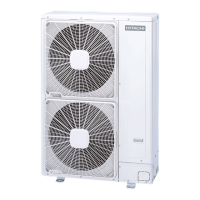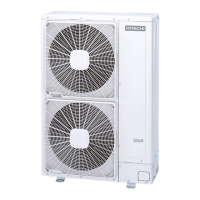
Do you have a question about the Hitachi RAS-3-HVNC and is the answer not in the manual?
| Cooling Capacity | 3.5 kW |
|---|---|
| Heating Capacity | 4.0 kW |
| Refrigerant | R410A |
| Power Supply | 220-240V, 50Hz |
| Indoor Unit Weight | 9 kg |
| Type | Split System |
| Outdoor Unit Dimensions (WxHxD) | 780 x 540 x 240 mm |
Covers general notes, introduction to the UTOPIA series, and its eco-friendly features.
Details safety symbols, warnings, and essential norms and regulations for handling the equipment.
Provides classification and details for outdoor and indoor units, including accessory codes.
Highlights critical safety precautions for unit installation, including DANGER and CAUTION notices.
Provides guidelines for safely transporting outdoor units, including hanging methods and gross weights.
Illustrates the center of gravity for various outdoor unit models to ensure safe handling during installation.
Lists factory-supplied accessories, such as flare nuts for refrigerant piping, ensuring all parts are included.
Specifies required installation space and basic dimensions for different unit models to ensure proper airflow.
Details proper placement for outdoor units, including foundation, drainage, and strong wind considerations.
Covers installation of optional accessories like air flow guides, wind guards, and snow protection hoods.
Provides essential guidelines on piping materials, principles, suspension, and brazing techniques.
Details the procedure for connecting piping to outdoor units, including stop valve operation and torque specifications.
Outlines the maximum refrigerant piping lengths, system combinations, and height differences allowed.
Explains the procedure for charging refrigerant, including pressure checks and quantity calculations.
Addresses maximum permitted HFC concentration, calculation methods, and countermeasures for refrigerant leaks.
Covers procedures for using existing pipes with R22 or R407C, including cleaning and renewal kit usage.
Details the connection and installation of drain bosses for outdoor units to manage condensate discharge.
Covers essential safety precautions and general checks for electrical wiring work.
Provides diagrams and instructions for correctly wiring the outdoor unit's power and transmission cables.
Details the quantity, position, and function of DIP switches and RSW switches for various settings.
Explains common wiring practices between indoor and outdoor units, including wire size and breaker recommendations.
Describes the H-LINK II system features, specifications, and connection examples for multiple units.
Details individual and simultaneous operation modes, and system control logic.
Provides detailed electrical wiring diagrams for various models and power configurations.
Explains the control logic for various components like the inverter compressor and expansion valves.
Details the connectors, switches, and LEDs on the outdoor unit's Printed Circuit Boards (PCBs).
Outlines safety devices and settings for protecting the compressor and other critical components.
Illustrates operational sequences for cooling, dry, heating, and defrost modes.
Describes various standard control functions like freezing protection and high-pressure prevention.
Details available ports and signals for configuring optional functions via the outdoor unit's 7-segment display.
Explains how to set and describe various optional functions using the 7-segment display.
Lists available optional functions that can be set using the HITACHI remote control switch (PC-ART).
Covers essential checks before initiating the test run, including power supply and refrigerant.
Provides a step-by-step guide for performing a test run using the PC-ART remote control.
Details the process for conducting a test run using the PC-ARF remote control switch.
Explains how to perform a test run using a wireless remote control switch.
Describes how to conduct a test run directly from the outdoor unit using DIP switches.
Provides a comprehensive checklist for verifying system operation and component status during test runs.
Guides users through basic checks using the 7-segment display and power supply issues.
Covers alarm displays, codes for outdoor/indoor units, and troubleshooting steps based on alarm codes.
Explains how to use the remote controller (PC-ART, PC-ARF) and 7-segment display for troubleshooting.
Details procedures for checking key components like the DIP-IPM inverter, capacitors, fan motors, and expansion valves.
Lists cycle and structural parts, along with a parts table for the RAS-(2-2.5)HVNP model.
Provides a list of cycle and structural parts and a parts table for the RAS-3HVNC model.
Details cycle, structural, electrical parts, and parts names for the RAS-3HVNPE model.
Lists cycle, structural, electrical parts, and parts names for the RAS-(4-6)H(V)NPE models.
Provides cycle, structural, electrical parts, and parts names for the RAS-(4-6)H(V)NCE models.
Details cycle, structural, electrical parts, and parts names for the RAS-(8-10)HN(P/C)E models.
Lists cycle, structural, electrical parts, and parts names for the RAS-12HN(P/C) model.
Provides an introduction to servicing operations, including safety precautions and notes.
Details the procedures for removing major components of outdoor units for servicing.
Provides detailed servicing procedures for outdoor units in the Premium series.
Details servicing procedures for outdoor units in the Standard series.
Covers inverter specifications, time charts, protective functions, and overload control.
Explains thermistors used in outdoor units and provides characteristics for temperature monitoring.
Details the specifications and operation of the electronic expansion valve.
Describes the function and operation of high-pressure protection devices in various models.
Provides specifications and circuit diagrams for noise filters used with different power supplies.
Details the specifications and usage of capacitors for changing AC to DC current for the inverter.
Provides specifications for reactors used in 3-phase and 1-phase inverter circuits.
Explains the reliable mechanism for low vibration/sound and the principle of compression.
Covers essential checks for power source, wiring, compressor issues, and installation space.
Details maintenance procedures for indoor and outdoor units, including fan motors, heat exchangers, and electrical equipment.
Provides a template for recording service and maintenance activities.
Details how to use the 7-segment display for recording service and maintenance data.
Explains how to use the remote control switch for recording service and maintenance data.
Provides a detailed procedure for the pump-down method when replacing the compressor.












